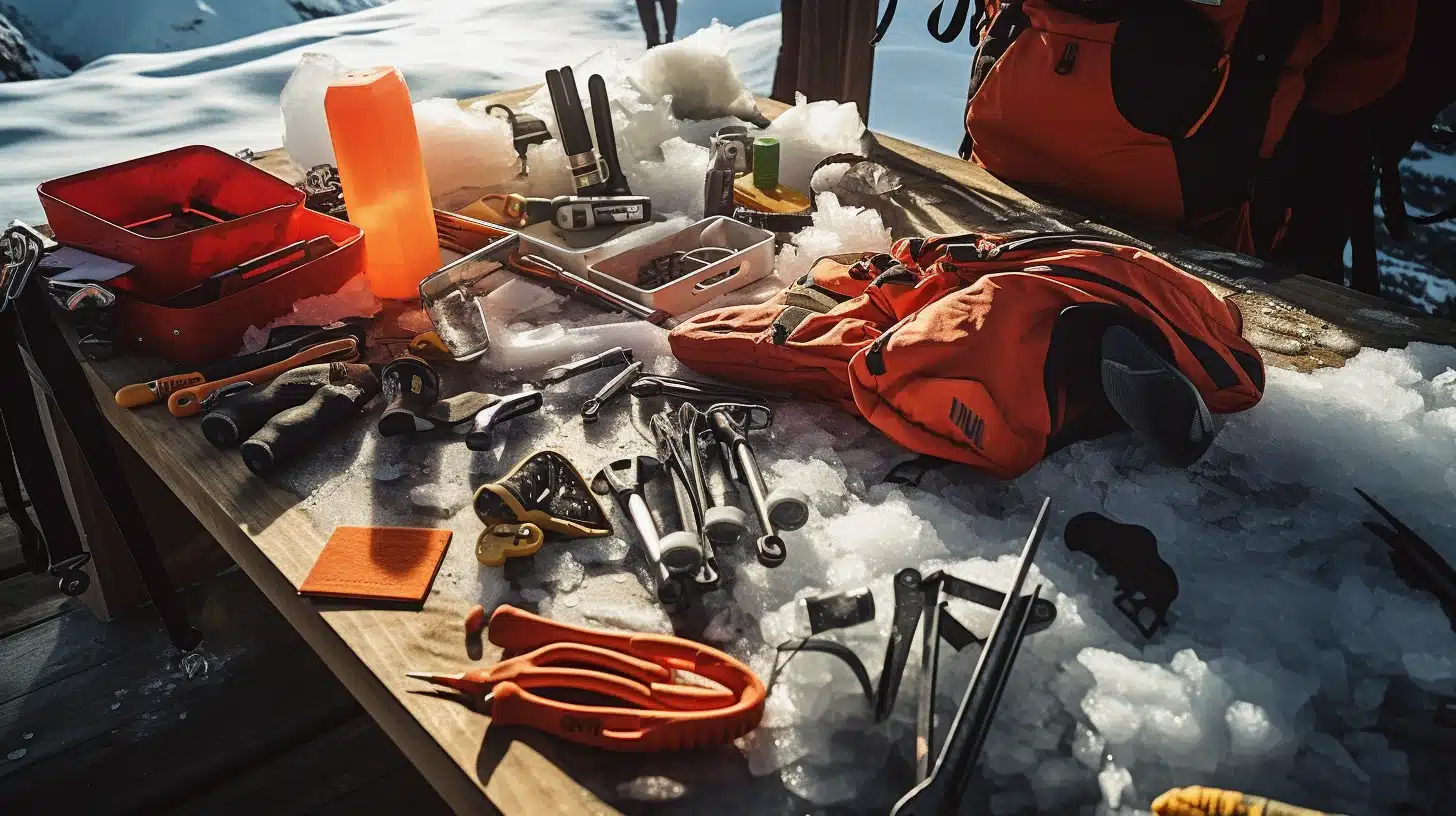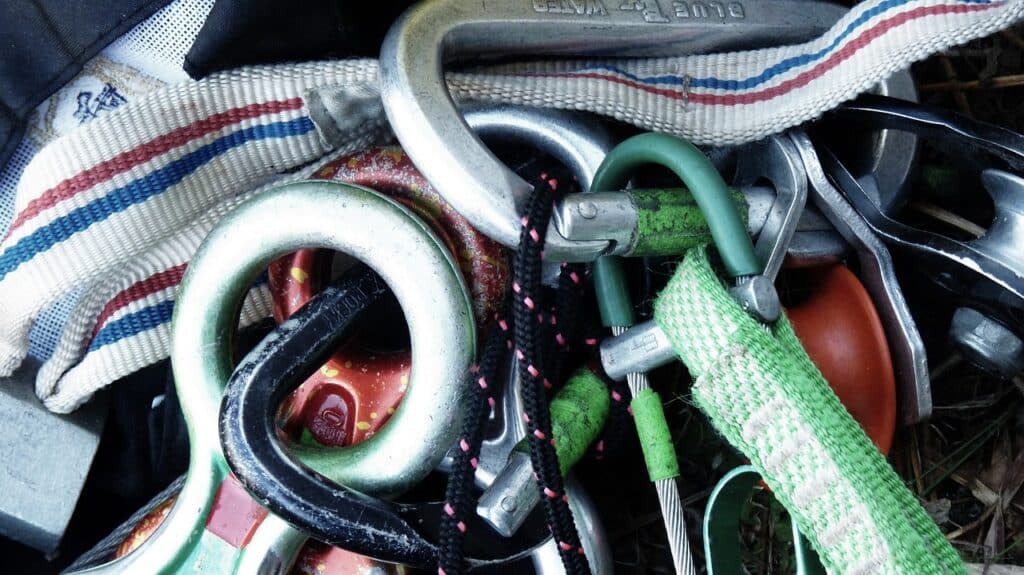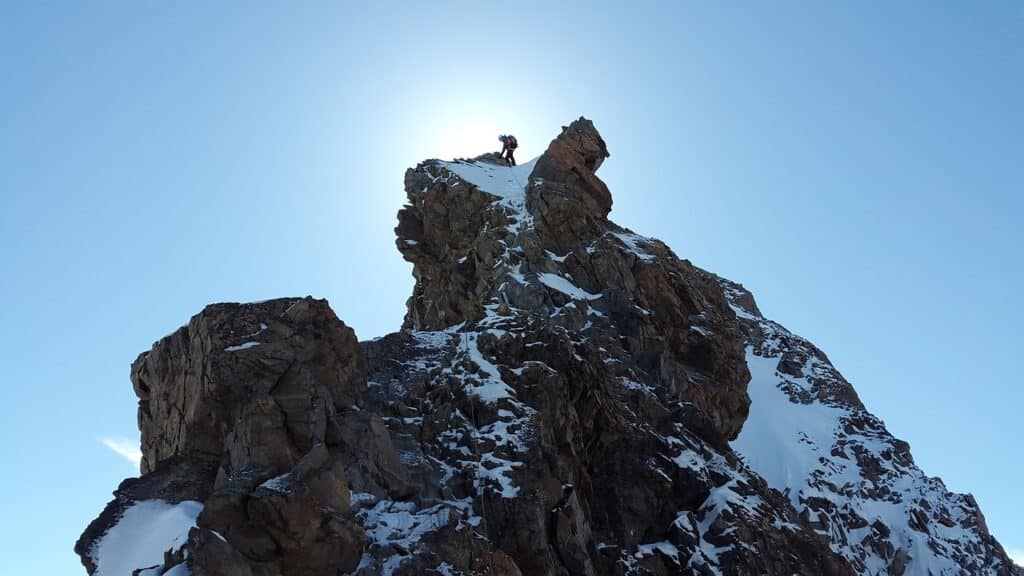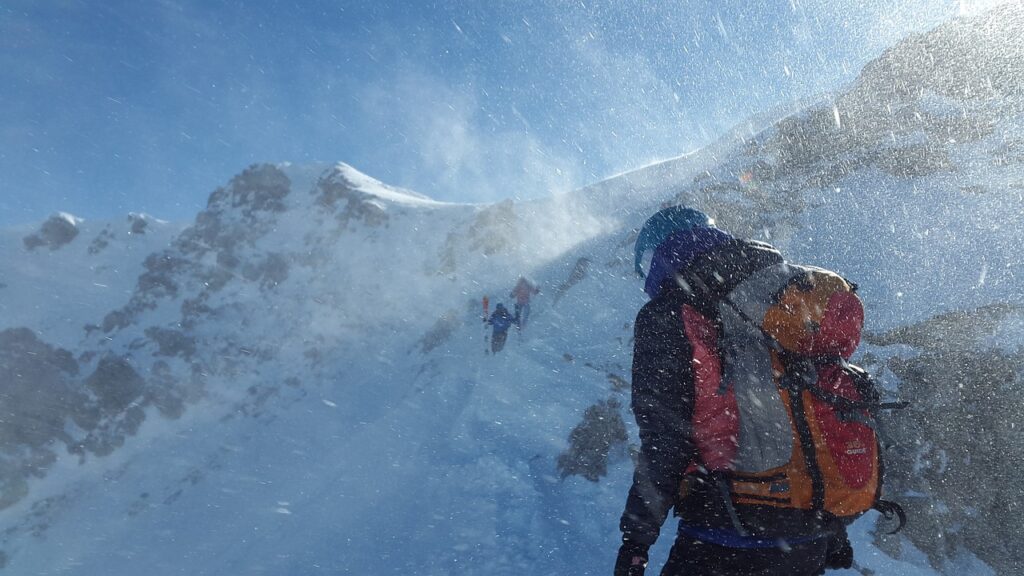Table of Contents
ToggleIce Climbing: An Introduction
Ice climbing is an exhilarating and challenging sport that involves scaling frozen waterfalls, ice formations, and icy rock faces. It combines elements of mountaineering and rock climbing, requiring specialized gear, techniques, and a keen understanding of the unique environment in which it takes place.
What is Ice Climbing?
Ice climbing is a type of mountaineering that involves ascending frozen waterfalls, ice-covered rock faces, or cliffs covered with ice formations. Climbers rely on various tools and equipment to navigate the icy terrain and protect themselves from potential hazards. These tools include ice screws, ice axes, crampons, and harnesses.
The sport demands physical strength, endurance, and mental focus. Climbers must carefully plan their routes, assess ice conditions, and make calculated decisions to ensure safety and successful ascents. Ice climbing is not only a physical challenge but also a mental one, as climbers must remain calm and composed in potentially hazardous situations.
Dangers and Risks of Ice Climbing
Ice climbing can be a dangerous activity, with hazards such as falling ice, avalanches, and the risk of injury from falls. The icy terrain presents additional challenges, as the conditions can be unpredictable and vary significantly from one climb to another. It is essential for climbers to have proper training, experience, and respect for the environment to mitigate these risks.
To understand the potential dangers and risks associated with ice climbing, it is helpful to analyze real-life scenarios. In a video by professional ice climber Will Gadd, a fall during an ice climbing ascent is captured, highlighting the seriousness of the risks involved. The climbers in the video express their shock at the fall, emphasizing that falling on ice is something they can’t imagine happening or would try to avoid at all costs.
The video prompts discussions about the importance of not falling on ice and the need for proper protection. It also highlights the necessity of learning from mistakes and continually improving climbing skills to minimize risks. These discussions reinforce the importance of proper education, training, and understanding of the sport to ensure the safety of ice climbers.
When approaching ice climbing, it is crucial to recognize the inherent risks and take appropriate precautions. This includes obtaining proper training, using suitable gear, and staying informed about ice conditions. By understanding the dangers and risks associated with ice climbing, climbers can make informed decisions, enhance their skills, and enjoy the sport with maximum safety in mind.
Essential Gear for Ice Climbing
When it comes to ice climbing, having the right gear is essential for safety and success on the ice. Here are some of the key pieces of equipment that every ice climber should have:
Ice Screws: The Primary Protection
Ice screws are one of the most important tools for protection in ice climbing. These specialized devices are designed to be screwed into the ice, providing a secure anchor point for the climber’s rope. Ice screws come in various lengths and sizes to accommodate different ice thicknesses and densities. It’s crucial for climbers to carry a variety of screw lengths to ensure they have the right size for the ice conditions they encounter.
Proper placement of ice screws is vital for safety. Climbers should clear away any damaged or uneven ice before inserting the screw to ensure it is securely placed in good ice. It’s recommended to have longer screws for thicker ice or to clear away the first layer of ice before placing the screw.
Crampons: Traction on Ice
Crampons are metal attachments that climbers wear on their boots to provide traction on ice and compacted snow. They feature sharp spikes or points that dig into the ice, allowing climbers to maintain grip and stability. Crampons typically have multiple points, known as front points, that provide additional traction on steep ice.
When choosing crampons for ice climbing, it’s important to consider the type of climbing you’ll be doing. General mountaineering crampons are suitable for less technical ice climbing, while specialized ice climbing crampons have more aggressive front points for enhanced performance on steep ice. It’s crucial to ensure that your crampons are properly fitted to your boots to maximize their effectiveness and minimize the risk of slipping.
Ice Axes: Versatile Tools for Climbing
Ice axes are essential tools for ice climbers. They provide stability, balance, and the ability to arrest falls on ice. Ice axes have a curved shaft and a pick at one end, which is used to strike the ice and provide leverage for upward movement. The other end of the ice axe features an adze or a hammer, which can be used for clearing ice or hammering in pitons.
When selecting an ice axe, consider the type of climbing you’ll be doing. General mountaineering axes are suitable for less technical ice climbing, while technical ice climbing axes have a more aggressive design with a curved shaft and a more aggressive pick. It’s important to choose an ice axe that is appropriate for your skill level and the difficulty of the routes you plan to climb. Proper technique and training are essential when using ice axes to ensure safe and effective climbing.
Rope Systems: Ensuring Safety
A reliable rope system is crucial for safety in ice climbing. Climbers use ropes to protect themselves from falls and to provide a means of communication and rescue. When ice climbing, it’s common to use a double rope system, where two ropes are employed simultaneously. This allows for redundancy and increased safety in case one rope becomes damaged or compromised.
Choosing the right rope for ice climbing is important. It should be designed for the specific demands of ice climbing, including resistance to freezing and durability in abrasive conditions. It’s also essential to properly maintain and care for your ropes to ensure their longevity and performance.
By having the essential gear of ice screws, crampons, ice axes, and a reliable rope system, ice climbers can enhance their safety and increase their chances of a successful climb. Remember to always use proper techniques, receive adequate training, and assess ice conditions to ensure a safe and enjoyable ice climbing experience.
Techniques and Strategies for Ice Climbing
When it comes to ice climbing, developing the right set of skills and strategies is crucial for a safe and enjoyable experience on the ice. Whether you’re a beginner or looking to improve your ice climbing abilities, following these techniques and strategies can help you progress and build confidence.
Learning Ice Climbing: Courses and Skills
Taking a course is essential for learning ice climbing. These courses provide instruction on safety, technique, and equipment, helping climbers gain the necessary knowledge and skills to navigate the ice with confidence. By learning from experienced instructors, you’ll receive valuable guidance on proper ice climbing techniques and equipment usage.
A comprehensive ice climbing course typically covers topics such as basic climbing skills, understanding ice conditions, efficient movement on ice, and self-rescue techniques. These courses are designed to provide a solid foundation for beginners and help intermediate climbers refine their skills.
Starting with Basic Climbing Skills
Before attempting ice climbing, it is recommended to start with basic climbing skills. This includes learning rock climbing techniques, developing physical strength and endurance, and gaining experience on different types of terrain. By mastering these fundamental skills, you’ll have a solid foundation to build upon when transitioning to ice climbing.
Basic rock climbing skills such as footwork, balance, and body positioning are transferable to ice climbing. Practicing on rock surfaces allows you to focus on movement and technique without the additional challenges posed by ice. Additionally, building strength and endurance through regular climbing sessions will contribute to your overall ability to tackle ice climbs.
Progressing Gradually: Building Confidence
Progressing gradually is important in ice climbing. It is recommended to start with easy climbs and gradually increase the difficulty level as your skills and experience improve. This approach allows you to build confidence, master techniques, and minimize the risks associated with more challenging climbs.
For those aiming to lead ice climbs, it is suggested to gain experience by top-roping initially. Will Gadd, a renowned ice climber, suggests top-roping around 150 pitches of ice before attempting to lead. This aligns with the author’s own experience, as they became comfortable leading ice after gaining extensive top-roping experience.
While there may not be a consensus, a learning process similar to that of ice or traditional rock climbing is often recommended for trad mixed climbing. Starting with top-roping allows you to practice movement, develop techniques, and gradually work your way up to more difficult climbs.
By learning from experienced climbers, practicing basic climbing skills, and progressing gradually, you can develop the necessary skills, techniques, and confidence to excel in ice climbing. Remember to always prioritize safety, use proper equipment, and stay informed about ice conditions before embarking on your ice climbing adventures.
Placing Ice Climbing Protection
When engaging in ice climbing, proper placement of protection is crucial to ensure the safety of climbers. Understanding ice conditions and types, as well as the correct placement of ice screws, are key elements in this process. Additionally, there are other forms of ice climbing protection that climbers can utilize for added safety.
Understanding Ice Conditions and Types
Before placing any protection, it’s essential to assess the ice conditions and types. Ice conditions can vary greatly, from solid and stable ice to fragile and brittle ice. Climbers should be aware of the current weather conditions, the temperature, and any recent changes in ice formation. This knowledge helps in determining the strength and reliability of the ice, enabling climbers to make informed decisions regarding protection placement.
Ice types can range from clear, blue ice to frosted or layered ice. Each type requires specific techniques and equipment for effective protection. By understanding the characteristics of different ice types, climbers can adapt their strategy and choose the appropriate protection for the given conditions.
Proper Placement of Ice Screws
Ice screws are the primary form of protection in ice climbing. These specialized tools are designed to be placed into the ice, providing a secure anchor point for climbers. Proper placement of ice screws is crucial for maximum strength and security.
When placing ice screws, it is recommended to space them at least 20 cm (8 inches) apart. This spacing ensures that each ice screw provides independent protection and minimizes the risk of multiple screws failing simultaneously. Additionally, the screws should be inserted at a slight upward angle to prevent them from pulling out. This angle helps to distribute the load and improves the overall stability of the protection.
The length and diameter of ice screws should be chosen based on the ice conditions and the desired level of protection. Longer screws are used for thicker ice, while shorter screws are suitable for thinner ice. It’s important to select the appropriate size to ensure optimal anchoring and reliability. For a comprehensive guide on ice screws, please refer to our article on ice climbing gear.
Other Forms of Ice Climbing Protection
In addition to ice screws, there are other forms of protection that climbers can employ in ice climbing. These include ice hooks, ice pitons, and ice threads. Each of these tools has its own application and limitations.
Ice hooks are specialized tools used to secure oneself on steep ice. They can provide temporary placements and aid in maintaining balance while climbing. Ice pitons, on the other hand, are strong and durable metal stakes that can be hammered into the ice for added protection. They are particularly useful when encountering ice features that are difficult to protect with ice screws alone.
Ice threads are created by drilling holes into the ice and inserting threaded anchors. These anchors can then be used to attach slings or carabiners, providing reliable protection points. Ice threads are commonly used in areas where ice screws might not be suitable or when constructing anchors for belaying.
By exploring and utilizing these different forms of ice climbing protection, climbers can enhance their safety and gain confidence in their climbs. It’s important to continuously assess ice conditions, use proper techniques, and select the appropriate protection for each situation. Always prioritize safety and stay informed about the latest advancements and best practices in ice climbing protection.
Additional Considerations for Ice Climbing Protection
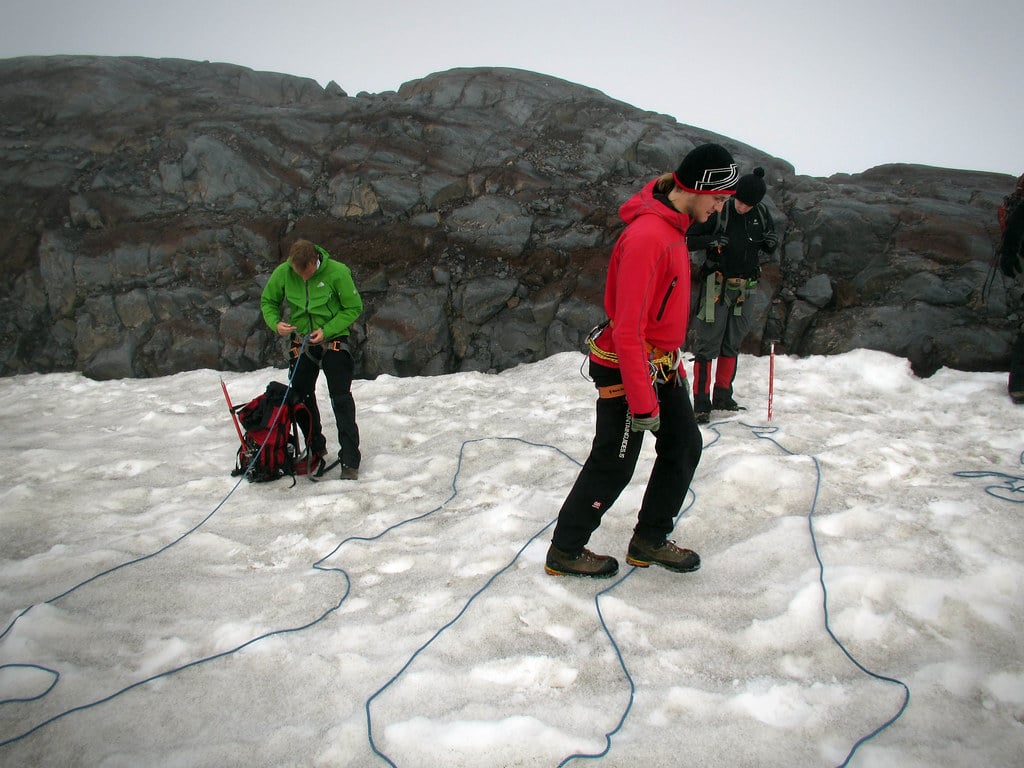
When it comes to ice climbing, there are some additional considerations to keep in mind regarding protection. These considerations can play a crucial role in ensuring your safety and the success of your climbing endeavors.
Top Roping vs. Leading in Ice Climbing
In ice climbing, there is a debate between top roping and leading. Some climbers suggest that before leading, it’s beneficial to top rope a significant number of pitches, such as 150 pitches of ice, to gain experience and build confidence. This approach allows climbers to understand the intricacies of ice climbing and become comfortable with the unique challenges it presents.
However, if you are solid with traditional rock climbing and the route has minimal ice, leading a mixed route without top roping may be an option. Leading mixed climbs eliminates the risk associated with ice protection but still requires caution to avoid catching crampon points on rock. The decision between top roping and leading ultimately depends on your experience, skill level, and the specific characteristics of the climb.
Quality of Ice and Gear Placement
The quality of ice and the placement of gear are crucial factors to consider when ice climbing. The quality of ice can vary, and it’s important to assess the conditions before placing gear. Ice screws tend to hold well in good ice, but conditions with icy cracks or lots of snow can make gear placement more challenging. It’s essential to evaluate the integrity of the ice and ensure it is suitable for reliable protection.
When placing ice screws, it is recommended to angle them at 90 degrees to the ice or at a slight downward angle of 10-15 degrees. In good ice conditions, angling the screw in the direction of pull can enhance its strength and reliability. It’s important to note that ice screws are not as strong as bolts, and precautions should be taken to prevent damage to the screw or associated gear.
In situations where the ice is not suitable for traditional ice screw placement, climbers can get creative. Tying off an icicle or utilizing other natural features can provide alternative forms of protection. Carrying slings and being resourceful allows climbers to adapt to different conditions and ensure their safety.
Using Screamers for Added Protection
Screamers are devices that can provide added protection in ice climbing. These devices are designed to absorb energy directly and increase the time interval of a fall, allowing the rope to absorb more energy. Screamers are particularly useful when leaving the belay, where the most force could be applied to a screw in the event of a fall.
Standard screamers can effectively reduce peak loads by 3-4kN in any climbing system. However, it’s not necessary to carry screamers for every screw. They should be used strategically, especially in situations where the potential force on a screw is high. By using screamers, climbers can enhance the overall safety of their ice climbing experience.
By considering these additional factors in ice climbing protection, you can make informed decisions to ensure your safety on the ice. Whether you choose to top rope or lead, evaluate the quality of the ice, or utilize screamers for added protection, these considerations will contribute to a successful and enjoyable ice climbing adventure.

